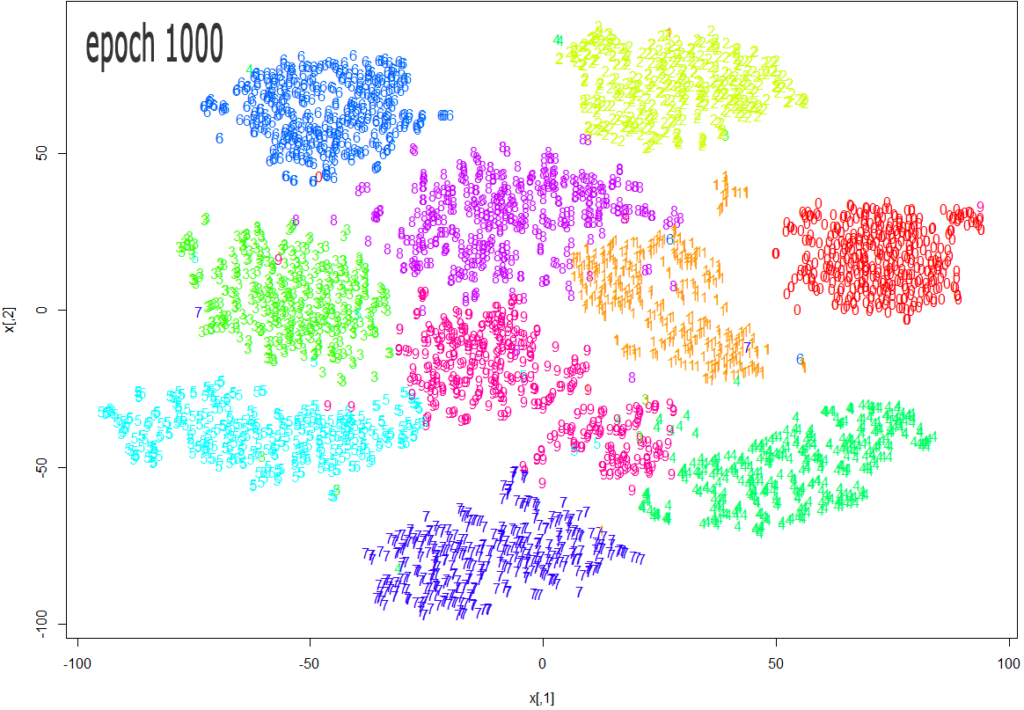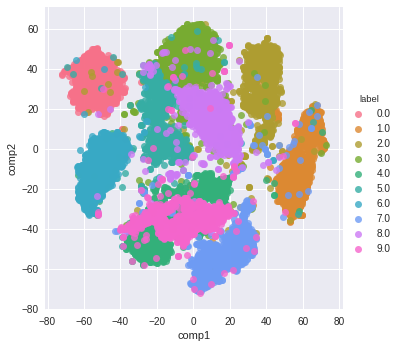【转载】 机器学习数据可视化 (t-SNE 使用指南)—— Why You Are Using t-SNE Wrong
原文地址:
https://towardsdatascience.com/why-you-are-using-t-sne-wrong-502412aab0c0
=====================================

Source: https://datascienceplus.com/multi-dimensional-reduction-and-visualisation-with-t-sne/
t-SNE has become a very popular technique for visualizing high dimensional data. It’s extremely common to take the features from an inner layer of a deep learning model and plot them in 2-dimensions using t-SNE to reduce the dimensionality. Unfortunately, most people just use scikit-learn’s implementation without actually understanding the results and misinterpreting what they mean.
While t-SNE is a dimensionality reduction technique, it is mostly used for visualization and not data pre-processing (like you might with PCA). For this reason, you almost always reduce the dimensionality down to 2 with t-SNE, so that you can then plot the data in two dimensions.
The reason t-SNE is common for visualization is that the goal of the algorithm is to take your high dimensional data and represent it correctly in lower dimensions — thus points that are close in high dimensions should remain close in low dimensions. It does this in a non-linear and local way, so different regions of data could be transformed differently.
t-SNE has a hyper-parameter called perplexity. Perplexity balances the attention t-SNE gives to local and global aspects of the data and can have large effects on the resulting plot. A few notes on this parameter:
- It is roughly a guess of the number of close neighbors each point has. Thus, a denser dataset usually requires a higher perplexity value.
- It is recommended to be between 5 and 50.
- It should be smaller than the number of data points.
The biggest mistake people make with t-SNE is only using one value for perplexity and not testing how the results change with other values. If choosing different values between 5 and 50 significantly change your interpretation of the data, then you should consider other ways to visualize or validate your hypothesis.
It is also overlooked that since t-SNE uses gradient descent, you also have to tune appropriate values for your learning rate and the number of steps for the optimizer. The key is to make sure the algorithm runs long enough to stabilize.
There is an incredibly good article on t-SNE that discusses much of the above as well as the following points that you need to be aware of:
- You cannot see the relative sizes of clusters in a t-SNE plot. This point is crucial to understand as t-SNE naturally expands dense clusters and shrinks spares ones. I often see people draw inferences by comparing the relative sizes of clusters in the visualization. Don’t make this mistake.
- Distances between well-separated clusters in a t-SNE plot may mean nothing. Another common fallacy. So don’t necessarily be dismayed if your “beach” cluster is closer to your “city” cluster than your “lake” cluster.
- Clumps of points — especially with small perplexity values — might just be noise. It is important to be careful when using small perplexity values for this reason. And to remember to always test many perplexity values for robustness.
Now — as promised some code! A few things of note with this code:
- I first reduce the dimensionality to 50 using PCA before running t-SNE. I have found that to be good practice (when having over 50 features) because otherwise, t-SNE will take forever to run.
- I don’t show various values for perplexity as mentioned above. I will leave that as an exercise for the reader. Just run the t-SNE code a few more times with different perplexity values and compare visualizations.
from sklearn.datasets import fetch_mldata
from sklearn.manifold import TSNE
from sklearn.decomposition import PCA
import seaborn as sns
import numpy as np
import matplotlib.pyplot as plt
# get mnist data
mnist = fetch_mldata("MNIST original")
X = mnist.data / 255.0
y = mnist.target
# first reduce dimensionality before feeding to t-sne
pca = PCA(n_components=50)
X_pca = pca.fit_transform(X)
# randomly sample data to run quickly
rows = np.arange(70000)
np.random.shuffle(rows)
n_select = 10000
# reduce dimensionality with t-sne
tsne = TSNE(n_components=2, verbose=1, perplexity=50, n_iter=1000, learning_rate=200)
tsne_results = tsne.fit_transform(X_pca[rows[:n_select],:])
# visualize
df_tsne = pd.DataFrame(tsne_results, columns=['comp1', 'comp2'])
df_tsne['label'] = y[rows[:n_select]]sns.lmplot(x='comp1', y='comp2', data=df_tsne, hue='label', fit_reg=False)
And here is the resulting visualization:

=========================================
【转载】 机器学习数据可视化 (t-SNE 使用指南)—— Why You Are Using t-SNE Wrong的更多相关文章
- 前端数据可视化echarts.js使用指南
一.开篇 首先这里要感谢一下我的公司,因为公司需求上面的新颖(奇葩)的需求,让我有幸可以学习到一些好玩有趣的前端技术,前端技术中好玩而且比较实用的我想应该要数前端的数据可视化这一方面,目前市面上的数据 ...
- 机器学习-数据可视化神器matplotlib学习之路(五)
这次准备做一下pandas在画图中的应用,要做数据分析的话这个更为实用,本次要用到的数据是pthon机器学习库sklearn中一组叫iris花的数据,里面组要有4个特征,分别是萼片长度.萼片宽度.花瓣 ...
- 机器学习-数据可视化神器matplotlib学习之路(四)
今天画一下3D图像,首先的另外引用一个包 from mpl_toolkits.mplot3d import Axes3D,接下来画一个球体,首先来看看球体的参数方程吧 (0≤θ≤2π,0≤φ≤π) 然 ...
- 机器学习-数据可视化神器matplotlib学习之路(三)
之前学习了一些通用的画图方法和技巧,这次就学一下其它各种不同类型的图.好了先从散点图开始,上代码: from matplotlib import pyplot as plt import numpy ...
- 机器学习-数据可视化神器matplotlib学习之路(二)
之前学习了matplotlib的一些基本画图方法(查看上一节),这次主要是学习在图中加一些文字和其其它有趣的东西. 先来个最简单的图 from matplotlib import pyplot as ...
- 机器学习-数据可视化神器matplotlib学习之路(一)
直接上代码吧,说明写在备注就好了,这次主要学习一下基本的画图方法和常用的图例图标等 from matplotlib import pyplot as plt import numpy as np #这 ...
- Python数据可视化编程实战pdf
Python数据可视化编程实战(高清版)PDF 百度网盘 链接:https://pan.baidu.com/s/1vAvKwCry4P4QeofW-RqZ_A 提取码:9pcd 复制这段内容后打开百度 ...
- python数据可视化编程实战PDF高清电子书
点击获取提取码:3l5m 内容简介 <Python数据可视化编程实战>是一本使用Python实现数据可视化编程的实战指南,介绍了如何使用Python最流行的库,通过60余种方法创建美观的数 ...
- Python Seaborn综合指南,成为数据可视化专家
概述 Seaborn是Python流行的数据可视化库 Seaborn结合了美学和技术,这是数据科学项目中的两个关键要素 了解其Seaborn作原理以及使用它生成的不同的图表 介绍 一个精心设计的可视化 ...
- 机器学习PAL数据可视化
机器学习PAL数据可视化 本文以统计全表信息为例,介绍如何进行数据可视化. 前提条件 完成数据预处理,详情请参见数据预处理. 操作步骤 登录PAI控制台. 在左侧导航栏,选择模型开发和训练 > ...
随机推荐
- Oracle常用命令收藏
查看数据库名 SELECT t.NAME FROM V$DATABASE t; 查看实例名 SELECT t.INSTANCE_NAME FROM V$INSTANCE t; 查看SID select ...
- Windows无法调节亮度
原因1:驱动问题 解决方式: 安装360驱动大师,一键安装. 也可以使用其他软件:如驱动精灵. 推荐使用电脑品牌本身的驱动软件:如联想:联想驱动管理 原因2:设备管理问题 解决方式: 计算机 -> ...
- Android 中的 perfboot工具
背景 开机首先加载bootloader,由bootloader启动kernel,然后运行init程序,有init启动Zygote,Zygote进程启动SystemServ进程,在SystemServe ...
- 机器学习(三)——K最临近方法构建分类模型(matlab)
K最临近(K-Nearest Neighbors,KNN)方法是一种简单且直观的分类和回归算法,主要用于分类任务.其基本原理是用到表决的方法,找到距离其最近的K个样本,然后通过K个样本的标签进行表决, ...
- 《DNK210使用指南 -CanMV版 V1.0》第一章 本书学习方法
第一章 本书学习方法 1)实验平台:正点原子DNK210开发板 2)章节摘自[正点原子]DNK210使用指南 - CanMV版 V1.0 3)购买链接:https://detail.tmall.com ...
- 全志科技A40i开发板规格书(四核ARM Cortex-A7,主频1.2GHz)
1.评估板简介 创龙科技TLA40i-EVM是一款基于全志科技A40i处理器设计的4核ARM Cortex-A7高性能低功耗国产评估板,每核主频高达1.2GHz,由核心板和评估底板组成. 评估板接口资 ...
- python实用总结
Python3 常用工具 1. 命令行快速搭建本地http服务器 python3 -m http.server 8000 在命令行中输入此命令,就会在当前目录下搭建http服务器,可以通过访问http ...
- Java 表达式执行引擎 jexl
介绍 JEXL的全称是Java表达式语言(Java Expression Language),简单的说,它可以配合我们的Java程序运算一些简单的表达式. 具体可以识别哪些表达式? 包含最基本的加减乘 ...
- Solo开发者社区-H5-Dooring, 开箱即用的零代码搭建平台
Dooring-Saas 是一款功能强大,高可扩展的零代码解决方案,致力于提供一套简单方便.专业可靠.无限可能的页面可视化搭建最佳实践.(Solo社区 投稿) 功能特点 可扩展, Dooring 实现 ...
- PowerBuilder编程新思维6.5:外传1(PowerPlume的设计与规划)
<第五部分 Otherside 意外的宝藏> 每一颗种子都有发芽的梦想.PowerPlume(孔雀翎)开发交流群:286502392 PowerBuilder编程新思维6.5:外传1 ...
